Beginner's guide to getting started, code examples and templates
AHK a scripting language for Windows to automate tasks, create keyboard shortcuts, build macros, develop graphical user interfaces and more. It compiles to .exe in a single click! Their documentation is extensive so I've put together some code so you can easily get started creating your own program.Beginner's guide to getting started
Let's create a low-complexity boiler plate to familiarize.Prerequisites
- Download AutoHotkey V1.1 from their official website.
- Get your favorite text editor ready. For AHK i like to use SciTE4AutoHotkey.
- Open your text editor and add this block of code below to the beginning of all your AHK scripts.
- anything written after a semi-colon
;is a comment used for note taking. It does not get read by the script and is only for developers to keep track of their code. You can see them being used in the block below. - Add this block of code below to the end of all your AHK scripts to ensure the app quits running when the GUI is closed.
SendMode Input ; Recommended for new scripts due to its superior speed and reliability. SetWorkingDir %A_ScriptDir% ; Ensures a consistent starting directory. #SingleInstance Force ; Replaces old instance of script automatically.
guiclose: exitapp
Your text file should now look like this. You are now ready to begin.
SendMode Input ; Recommended for new scripts due to its superior speed and reliability. SetWorkingDir %A_ScriptDir% ; Ensures a consistent starting directory. #SingleInstance Force ; Replaces old instance of script automatically.
guiclose: exitapp
Creating the GUI
Graphical User Interface
We will start with creating the GUI. Place the code below into your script between the two blocks of code above.
We will start with creating the GUI. Place the code below into your script between the two blocks of code above.
gui, show, w500 h200, massi.net AutoHotKey starter kit
gui, font, s20 gui, add, text, x90 y20, Low complexity boilerplate
gui, font, s12 gui, add, button, x25 y+20, Show text in box gui, add, edit, x+50 w200 vtext,
gui, add, Button, x25 y+20, Load checked programs gui, add, CheckBox, x+20 vnotepad , Notepad gui, add, checkbox, x+10 vcalculator, Calculator
gui, add, text, x20 y+30, Change GUI color gui, add, radio, x+20 group vrad1, white gui, add, radio, x+20 vrad2, blue gui, add, radio, x+10 vrad3, green gui, add, radio, x+10 vrad4, red
This is the end of the GUI. Add return to the end of the script.
return
✂
Your code should look like this. It has no functionality yet, just a GUI.
SendMode Input ; Recommended for new scripts due to its superior speed and reliability. SetWorkingDir %A_ScriptDir% ; Ensures a consistent starting directory. #SingleInstance Force ; Replaces old instance of script automatically. gui, show, w500 h200, massi.net AutoHotKey starter kit gui, font, s20 gui, add, text, x90 y20, Low complexity boilerplate gui, font, s12 gui, add, button, x25 y+20, Show text in box gui, add, edit, x+50 w200 vtext, gui, add, Button, x25 y+20, Load checked programs gui, add, CheckBox, x+20 vnotepad , Notepad gui, add, checkbox, x+10 vcalculator, Calculator gui, add, text, x20 y+30, Change GUI color gui, add, radio, x+20 group vrad1, white gui, add, radio, x+20 vrad2, blue gui, add, radio, x+10 vrad3, green gui, add, radio, x+10 vrad4, red return guiclose: exitapp
Run your code by saving it and double clicking the file or press the play button if you are using SciTE.
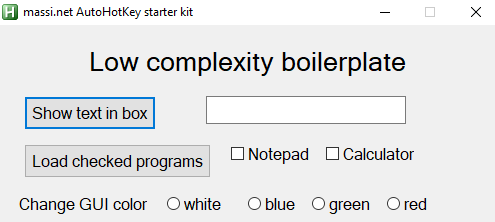
The buttons don't do anything yet. Let's continue.
Adding functionality
Adding functionality
Now that we have our GUI ready let's add some functionality.
Now that we have our GUI ready let's add some functionality.
The first button will show in a message box what was typed in the edit box. That action will be titled
show
- We must assign the button that will use this action the "show" variable. Action variables start with
g
gshow variable to the "Show text in box" button from before. The line should now look like this, after adding only gshow to it. You are not adding this line to the code, you are only adding the the 'gshow' action variable to the 'Show text in box' line
gui, add, button, x25 y+20 gshow, Show text in box
Let's create the action labeled
show:
- Button labels are followed by a colon
: - To fetch the information and pass it into the program we must add
gui, submit, nohideto the beginning of the function. - That will be followed by a message box with the title "Show text" that will grab from the variable "%text%", defined in the edit box earlier as "vtext". Dynamic variables must be enclosed in % signs.
- "return" will end the function.
show: gui, submit, nohide msgbox,, Show text,%text% return
Let's create the action labeled
run:
The second button will load the programs checked in the check boxes. Like before we must assign the button that will use this action the "run" variable. Add the grun variable to the "Load checked programs " button. You are not adding this line to the code, you are only adding the 'grun' action variable to the 'Load checked programs' line!
gui, add, button, x25 y+20 grun, Load checked programs
- Like before to fetch the information and pass it into the program we must add
gui, submit, nohideto the beginning of the function. - This action will have an "if" statement. "If" statements must have a variable and parameter. Our variable will be "notepad" and parameter will be 1 or 0. Checked is 1, unchecked is 0
- The conditions must be enclosed in regular brackets, and the action must be in curly brackets. The action will be to run notepad or calculator.
run: gui, submit, nohide If (notepad = 1) { Run, notepad.exe } If (calculator = 1) { Run, calc.exe } return
Let's create the action labeled
change:
The third action will change the color of the GUI depending on what radio button is checked. Radio button groups can only have one button marked at a time. - Like before to fetch the information and pass it into the program we must add
gui, submit, nohideto the beginning of the function. - Like before we must assign the buttons that will use the action label the variable "change".
gchange to the radio buttons.
You are not adding these lines to the code, you are only adding the action variable 'gchange' to the color lines!
gui, add, radio, x+20 group vrad1 gchange, white gui, add, radio, x+20 vrad2 gchange, blue gui, add, radio, x+10 vrad3 gchange, green gui, add, radio, x+10 vrad4 gchange, red
- Like before to fetch the information and pass it into the program we must add
gui, submit, nohideto the beginning of the function. - This action will have an "if" statement. "If" statements must have a variable and parameter. Our variable will be "rad1" and parameter will be 1 or 0. Checked is 1, unchecked is 0
- The conditions must be enclosed in regular brackets, and the action must be in curly brackets. The action will be to change colors of the gui with
gui, color, white
change: gui, submit, nohide if (rad1 = 1){ gui, color, white } if (rad2 = 1){ gui, color, blue } if (rad3 = 1){ gui, color, green } if (rad4 = 1){ gui, color, red } return
Running the program
Running the program
We have completed the program, the code should look like so.
We have completed the program, the code should look like so.
SendMode Input ; Recommended for new scripts due to its superior speed and reliability. SetWorkingDir %A_ScriptDir% ; Ensures a consistent starting directory. #SingleInstance Force ; Replaces old instance of script automatically. gui, show, w500 h200, massi.net AutoHotKey starter kit gui, font, s20 gui, add, text, x90 y20, Low complexity boilerplate gui, font, s12 gui, add, button, x25 y+20 gshow, Show text in box gui, add, edit, x+50 w200 vtext, gui, add, button, x25 y+20 grun, Load checked programs gui, add, CheckBox, x+20 vnotepad , Notepad gui, add, checkbox, x+10 vcalculator, Calculator gui, add, text, x20 y+30, Change GUI color gui, add, radio, x+20 group vrad1 gchange, white gui, add, radio, x+20 vrad2 gchange, blue gui, add, radio, x+10 vrad3 gchange, green gui, add, radio, x+10 vrad4 gchange, red return show: gui, submit, nohide msgbox,, Show text,%text% return run: gui, submit, nohide If (notepad = 1) { Run, notepad.exe } If (calculator = 1) { Run, calc.exe } return change: gui, submit, nohide if (rad1 = 1){ gui, color, white } if (rad2 = 1){ gui, color, blue } if (rad3 = 1){ gui, color, green } if (rad4 = 1){ gui, color, red } return guiclose: exitapp
Adding some text to the edit and clicking our first button...
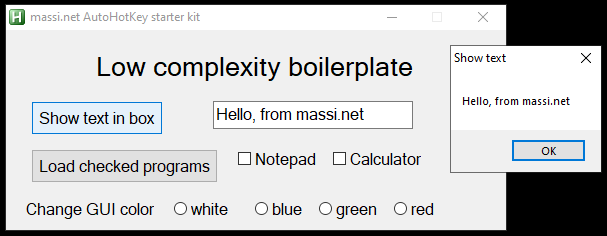
Seeing if our second button will load the program...

How are our checkboxes doing?...
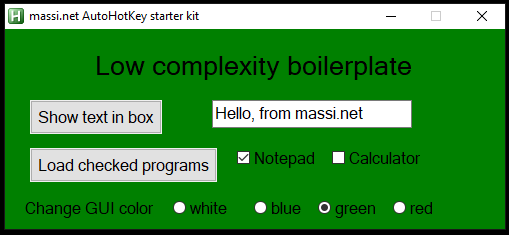
Looking great! But one last thing. Why don't we compile it into an executable program so that it can run on any Windows PC regardless of AutoHotKey installation. Right click the file and click "Compile Script". Your .exe file will appear.
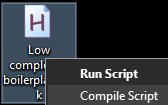
Your .exe file will appear.

boilerplate.ahk
Buttons
Show/Hide/Disable
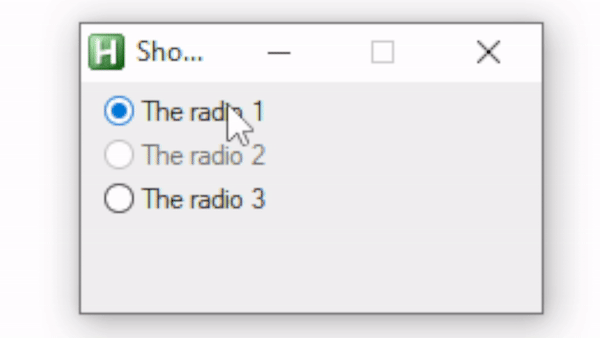 ShowHideDisable.ahk
ShowHideDisable.ahk
gui, show, w200 h100, Show/Hide/Disable button gui, add, radio ,vV1 gbutton1, The radio 1 gui, add, radio, vV2 gbutton1, The radio 2 gui, add, radio, vV3 gbutton1, The radio 3 guicontrol, disable, V2 return button1: gui, submit, NoHide if V1 = 1 GuiControl, show, V2 if V3 = 1 GuiControl, hide, V2 return
Radio
 radio.ahk
radio.ahk
gui, show, w200 h100, gui gui, color, white gui, add, radio, x10 y10 checked group vrad1 gradiolabel, white gui, add, radio, x10 vrad2 gradiolabel, blue gui, add, radio, x10 vrad3 gradiolabel, green gui, add, radio, x10 vrad4 gradiolabel, red gui, submit, nohide return radiolabel: gui, submit, nohide if(rad1==1) gui, color, white else if(rad2==1) gui, color, blue else if(rad3==1) gui, color, green else if (rad4 = true) gui, color, red return
Listbox
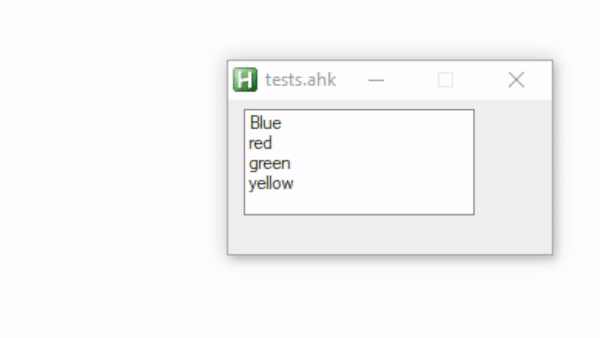 listbox.ahk
listbox.ahk
Gui, Show, w210 h100 Gui,Add,ListBox, w150 r5 8 vList1 gSubmit_All , Blue|red|green|yellow| return Submit_All: Gui, Submit, NoHide msgbox, % List1 return
Dropdown
 dropdown.ahk
dropdown.ahk
Gui, show, w100 h35 Gui, Add, DropDownList, w75, Option 1|Option 2|Option 3 return
Tabs
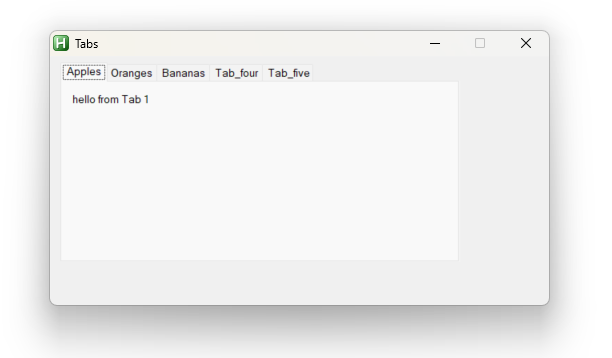 tabs.ahk
tabs.ahk
gui, show, w500 h250, Tabs Gui, add, tab3, w400 h200 -wrap, Apples|Oranges|Bananas|Tab_four|Tab_five| sleep 100 Gui, Tab, Apples Gui, add, text, x+10 y+10, hello from Tab 1 sleep 100 Gui, Tab, Oranges Gui, add, text, x+10 y+10, hello from Tab 2 sleep 100 Gui, Tab, Bananas Gui, add, text, x+10 y+10, hello from Tab 3 sleep 100 Gui, Tab, 4 Gui, add, text, x+10 y+10, hello from Tab 4 sleep 100 Gui, Tab, 5 Gui, add, text, x+10 y+10, hello from Tab 5 sleep 100 return
Templates
[Library] TAB v0.1 (Preview) - Add Functionality to the Tab Control
TAB_Library_v0.1.zip
MagicBox - Message Box Generator
MagicBox-1.0.4.7z
FindText - Capture screen image into text and then find it
FindText_GetText_JG.ahk
G33kDude/Chrome.ahk
Chrome.ahk_v1.2.zip
